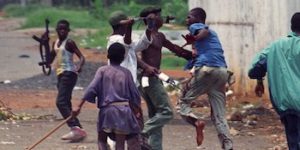
On this date in 1994, mass murder of Africans began in Rwanda. The slaughter occurred in the town of Kibye, Rwanda. The conflict was between two African tribes, the Hutus and Tutsis.
This massacre occurred at the Church of St. Jean-Pierre. Hutu militiamen heaved grenades at the confined crowd of Tutsis inside; also, Hutu militiamen dismembered many with machetes. Thousands of Tutsis were buried in mass graves after the bloodshed. More than 7,000 people were murdered in this act of genocide. For about 100 days, the Hutu militias, known in Rwanda as Interahamwe followed what evidence suggests was a clear and premeditated attempt to exterminate the country's ethnic Tutsi population.
When the bloodshed stopped, an estimated 500,000 people had been killed. The country's industrial infrastructure was gone, and much of its population had been dislocated. Commerce was paralyzed, and tourism ceased. The agricultural sector was ruined in a country where 95% of the population depended upon cash crops or subsistence farming. The gross domestic product of Rwanda for 1994 was cut in half. Humanitarian organizations working in the region recently reported that Rwanda's children have been the most vulnerable to the poverty and exploitation that followed the ethnic conflict.
The massacres left several hundred thousand orphaned children or separated from their parents. A recent UNICEF report estimates that 700,000 children, 18 percent of Rwanda's 4.2 million children, live in difficult circumstances.
Today, Rwanda has two public holidays that mourn the genocide. The national mourning period begins with Kwibuka (Remembrance), the national commemoration, on April 7 and concludes with Liberation Day on July 4. The week following April 7 is an official week of mourning, known as Icyunamo. As a result of the genocide, nations collaborated to establish the International Criminal Court to prosecute genocide, crimes against humanity, and war crimes.